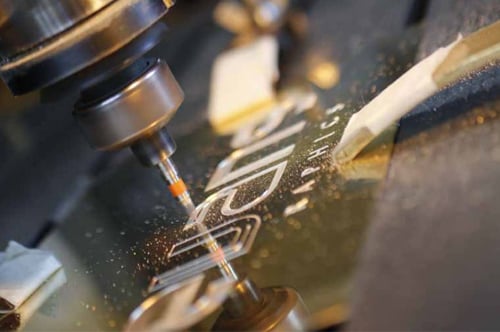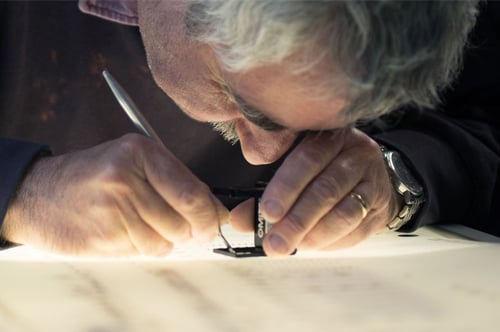Laser engraving is every bit the specialised printing method and one Evans Graphics provide as part of a suite of complementary services.
Engraved items allow for the finest detail and a personalised touch.
They range from trophies inscribed with the winners’ initials to ballpoint pens detailing the company name.
In fact, practically any design can be etched in this fashion, onto all manner of different materials.
In this blog, we’ll explain how the process works and why there are several iterations of laser engraving as we know it.
Laser Engraving Explained

In the simplest terms, laser engraving involves a material being heated by a laser beam. Not the sci-fi kind but rather one installed within a printer.
Depending on how long the substrate is exposed to said heat, its colour will gradually change and create a contrast.
If this process is prolonged, it may even burn or evaporate entirely.
Indeed, your chosen material will diminish with every ‘pulse’. The deeper the marks you want to create, the more pulses you require.
Before any of this takes place, artwork is finalised in design editing software before being sent to the laser via a printer dialogue/driver.
Settings are pre-defined before the material is placed into the laser chamber itself.
From here, the laser head will proceed to pass over the design, in the same way a standard Inkjet printer operates.
The laser beam is programmed to remove a layer when it comes into contact with the material.
Contrast is achieved when said layer is removed, owing to the fact the colour below contains multi-layer materials.
Benefits of Laser Engraving
Laser engraving brings with it many benefits.
Firstly, it’s incredibly quick. High repetition rates allow for faster turnaround times than possible using traditional methods such as annealing.
Furthermore, markings are durable and unlikely to be negatively affected by external factors. They are both permanent and resistant to abrasions.
Laser engraving provides great accuracy, realising a design exactly as intended.
It can also accommodate most materials – including aluminium and stainless steel but also gold.
Finally, it allows for more complex designs of a higher quality.
Being computer-driven, it can realise small text on small surface areas. The likes of fascia’s are often printed in this way.
Laser Engraving with Evans Graphics

Between them, the engraving team at Evans Graphics have more than 50 years’ worth of experience in this field.
We regularly put our expertise towards the likes of electronic control panels, steel pressings, rating plates and more… all requiring markings of some description.
We can also call upon industry-leading machinery when looking to laser engrave natural and synthetic materials alike.
Our powerful CO2 Laser Systems mark and engrave in next to no time, doing so in 1200dpi.
In addition, our Newing Hall CNC Mill-Grave allows for exceptional rotary engraving – more on that below.
Rotary Engraving
Rotary engraving differs from laser engraving by virtue of the fact it uses a rotary tool, typically a CNC Mill.
This spinner cutter either cuts or routs into the material and can be programmed to pass right through it if holes are desired. Alternatively, a pre-determined length can be set to facilitate engraved grooves.
Rotary engraving shares many of the same advantages as laser engraving. There are a handful of drawbacks, namely that it’s not ideal for small text, corners tend to have a small curve and large areas have been known to show a hatching pattern.
A popular variation on rotary engraving is Diamond Engraving, which uses the same machine, only with diamond-tipped, non-rotating cutters, better known as ‘gravers’.
Rotary engraving generally lends itself to materials that require deeper cuts.
Laser Etching
Laser etching shares the hallmarks of laser engraving but in this scenario the heat is deployed to melt the material in question.
On being melted down, the substance duly expands – leading to a raised mark very much intended.
Unlike laser engraving however, the depth is capped at 0.001”.
Laser Marking
Laser marking is not quite so widespread.
This method sees the surface material discoloured rather than removed.
Because the laser penetrates far less of the substrate, it changes its properties only slightly.
In this setup, a low powered beam is moved across the material and creates high contrast marks without actually disrupting it.
Oxidisation does occur as a result of heating though, which turns the material to black.
A low temperature is then applied to the metal in order to anneal the surface, which remains intact.
Colour Infill
Colour infill is an enhanced version of laser engraving.
It necessitates the surface material being covered with masking or transfer tape, before being checked for air bubbles.
The material is then placed into the laser as before, but after engraving has taken place, a coating of clear lacquer is applied to it.
Once this dries, printers will apply colours using professional spray paint.
Once that dries, the masking tape is duly removed and the finished, engraved product is revealed to include colour infill.
This option proves popular for signage, plaques, custom graphic overlays, awards and more.
The colour infill process is brilliantly documented in this video…
Engraving – and laser engraving in particular – is an ideal solution for anyone hoping to create something unique. A specialist service, it’s one Evans Graphics excel at.


